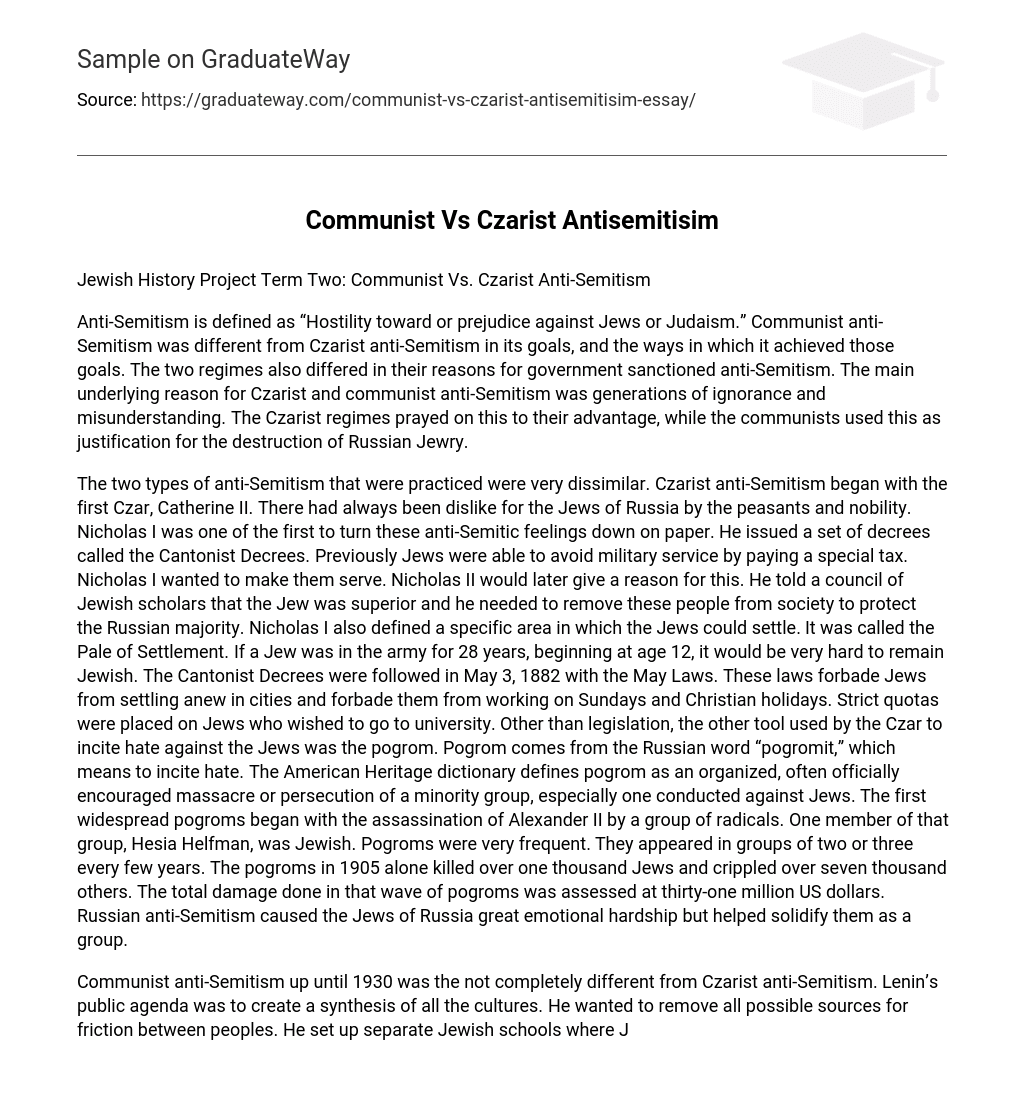Anti-Semitism is defined as “Hostility toward or prejudice against Jews or Judaism.” Communist anti-Semitism was different from Czarist anti-Semitism in its goals, and the ways in which it achieved those goals. The two regimes also differed in their reasons for government sanctioned anti-Semitism. The main underlying reason for Czarist and communist anti-Semitism was generations of ignorance and misunderstanding. The Czarist regimes prayed on this to their advantage, while the communists used this as justification for the destruction of Russian Jewry.
The two types of anti-Semitism that were practiced were very dissimilar. Czarist anti-Semitism began with the first Czar, Catherine II. There had always been dislike for the Jews of Russia by the peasants and nobility. Nicholas I was one of the first to turn these anti-Semitic feelings down on paper. He issued a set of decrees called the Cantonist Decrees. Previously Jews were able to avoid military service by paying a special tax. Nicholas I wanted to make them serve. Nicholas II would later give a reason for this. He told a council of Jewish scholars that the Jew was superior and he needed to remove these people from society to protect the Russian majority. Nicholas I also defined a specific area in which the Jews could settle. It was called the Pale of Settlement. If a Jew was in the army for 28 years, beginning at age 12, it would be very hard to remain Jewish. The Cantonist Decrees were followed in May 3, 1882 with the May Laws. These laws forbade Jews from settling anew in cities and forbade them from working on Sundays and Christian holidays. Strict quotas were placed on Jews who wished to go to university. Other than legislation, the other tool used by the Czar to incite hate against the Jews was the pogrom. Pogrom comes from the Russian word “pogromit,” which means to incite hate. The American Heritage dictionary defines pogrom as an organized, often officially encouraged massacre or persecution of a minority group, especially one conducted against Jews. The first widespread pogroms began with the assassination of Alexander II by a group of radicals. One member of that group, Hesia Helfman, was Jewish. Pogroms were very frequent. They appeared in groups of two or three every few years. The pogroms in 1905 alone killed over one thousand Jews and crippled over seven thousand others. The total damage done in that wave of pogroms was assessed at thirty-one million US dollars. Russian anti-Semitism caused the Jews of Russia great emotional hardship but helped solidify them as a group.
Communist anti-Semitism up until 1930 was the not completely different from Czarist anti-Semitism. Lenin’s public agenda was to create a synthesis of all the cultures. He wanted to remove all possible sources for friction between peoples. He set up separate Jewish schools where Jewish children learnt history “in a way that refrained from fostering national pride.” Jewish sections, called Yevsektsiia, were set up in all towns and levels of government. On October 20, 1918, the first meeting of all the regional Yevsektsiia passed a declaration stating, “all institutions operating in the Jewish quarter…have no longer any place in our life.” Consequently, a decree was passed in June 1919 that abolished all communal institutions and confiscated Jewish wealth. On March 31, 1919 Lenin made a public address denouncing anti-Semitism. Communist anti-Semitism was very organized and well thought out.
The ideas and goals behind communist anti-Semitism and Czarist anti-Semitism were very different. The Czar wanted Jews to feel unwanted. The end goal of all the work was to get the Jews to leave Russia and go somewhere else. Russia under the Czar was falling apart. The government used officially sanctioned hate of the Jewish people as a method of unifying the nation and redirecting their hatred and discontempt away from the czar. Communist anti-Semitism was different. The communists wanted the Jews to be like everyone else. Overt and blatant anti-Semitism was not tolerated. They tried very hard to get Jews to slowly acculturate, and eventually assimilate. The goal of Jewish public schools was to teach the children communist ideologies and to hasten their conversion to atheism. Without the moorings of Jewish institutions, Jews would assimilate quickly. Lenin and those who came after him understood what over time has become known as the Jewish paradox. When Jews are forced to convert, very few do. When Jews are not forced to convert, there are mass conversions. Russian anti-Semitism was much more overt, while Communist anti-Semitism was very subversive.
In conclusion, the communist revolution brought a great change to the types of anti-Semitism used against the Jews. Before the revolution the Czarist regime instituted government led hatred. The main manifestation of this anti-Semitism was the pogrom, which did great damage to Jewish life. The pre-soviet Russians tried their best to get their Jewish brethren to leave the country. All that changed with the communist revolution of 1919. The communists wanted the Jews to assimilate. They removed the moorings of their Jewish life and tried to destroy the Jewish community. A nation within a nation was as much a problem to the communists as it was to the French over two hundred years earlier. Neither made life easy for the Jews.
Preliminary Bibliography:
1.Baron, Salo W. The Russian Jew Under Tsars and Soviets. New York, New York; The Macmillan Company, 1964.
2.Kochen, Lionel. The Jews In Soviet Russia Since 1917. Oxford, England; Oxford University Press, 1978.
3.Stanislavski, Michael. Tsar Nicholas and the Jews. Philadelphia, Pennsylvania; The Jewish Publication Society, 1983.
4.Gottleib, Rabbi N. Z. In The Shadow of the Kremlin. New York, New York; Mesorah Publications Limited, 1985.
5.Korey, William. The Soviet Cage: Anti-Semitism in Russia. New York, New York; The Viking Press, 1973.





